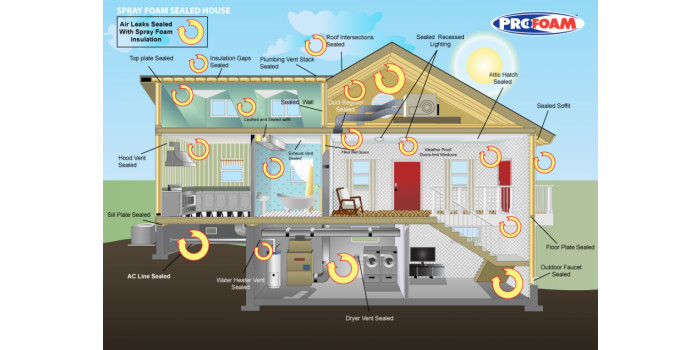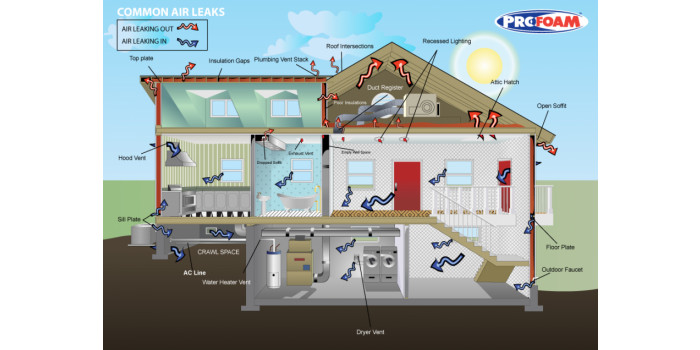For over 30 years, Profoam has been a trusted leader in spray foam insulation. Whether for residential, commercial, or industrial applications, our high-performance products deliver exceptional insulation results, ensuring energy efficiency and comfort in every setting.


Profoam offers a comprehensive range of spray foam insulation products, including closed-cell foam insulation, open-cell foam insulation, roofing foams, roof coatings, and polyurea coatings. Each product is engineered to provide superior insulation performance, making them ideal for homeowners and builders who demand the best in energy efficiency and durability.
Profoam’s sprayed-in-place polyurethane foam (SPF) insulation is a powerful solution for improving energy efficiency. By reducing heating and cooling loss by up to 40%, SPF offers substantial savings on energy bills. With twice the R-value per inch compared to traditional insulation, it not only insulates more effectively but also adds soundproofing and structural strength to any building.
Profoam’s spray foam insulation creates a durable, airtight seal around framing, ducts, wall outlets, windows, and more. This seamless barrier significantly reduces air infiltration, delivering long-term protection against energy loss and enhancing overall building performance.
Spray foam insulation doesn’t have to be complicated—and at Profoam, we’re here to make it simple. Made from high-performance polyurethane, spray foam is applied directly into the walls of homes or businesses to create a seamless thermal barrier.
There are two main types of spray foam insulation:
Both options provide excellent energy efficiency and can be tailored to meet your project’s specific needs.
When comparing insulation options, spray foam stands out as a superior choice over traditional fiberglass. Here’s why:
While the initial cost of spray foam insulation is higher, the long-term energy savings, durability, and performance offer a strong return on investment. In short, it’s a smart, future-proof choice for homeowners and builders alike.
If you're planning a home retrofit, spray foam insulation is a smart, long-term solution—especially for those living in extreme climates. Its superior insulating power helps maintain indoor comfort year-round while dramatically improving energy efficiency.
Unlike traditional fiberglass, which typically lasts 20 years, spray foam insulation can last up to 80 years. That’s six decades of additional performance, making it a cost-effective investment that pays for itself over time through reduced energy bills and lower maintenance costs.
The biggest advantage of retrofitting your home with spray foam insulation is the significant energy savings. By creating a tight thermal envelope, spray foam reduces heating and cooling demands—cutting utility bills and lowering your environmental impact.
But the benefits don’t stop there. Spray foam also enhances comfort by eliminating drafts, stabilizing indoor temperatures, and reducing outside noise. The result? A quieter, cozier, and more efficient home all year long.
While spray foam insulation offers many benefits, retrofitting isn’t always the best option—especially in areas like main exterior walls. Unless a full renovation is already planned, accessing these spaces can be invasive and costly.
In such cases, it may be more practical to focus on areas like attics, basements, crawl spaces, or rim joists where installation is less disruptive but still delivers significant energy efficiency gains.
Attics are one of the most effective areas to insulate with spray foam. Since heat naturally rises, a poorly insulated attic can lead to significant energy loss—especially during the colder months.
Spray foam insulation forms an airtight seal, preventing warm air from escaping through the roof and reducing the workload on your HVAC system. This not only boosts energy efficiency but also helps maintain more consistent indoor temperatures throughout the year.
Installing spray foam insulation is a specialized process that requires professional expertise. It’s not a DIY project, and it may not be the best fit for every home. That’s why it’s essential to consult with an experienced insulation contractor who can assess your property and recommend the right solution.
The Profoam Certified Contractor Network is a trusted resource for finding qualified professionals who are trained to install spray foam insulation correctly and efficiently. Whether you're planning a retrofit or a new build, start with a contractor you can count on.